In today’s ever-evolving work landscape, the home office has become an indispensable sanctuary for many. But what if your living space is more cozy than commodious?
Fear not! We’ve curated a cornucopia of 55 small home office ideas to help you transform even the most diminutive nook into a productivity powerhouse. From ingenious storage solutions to multifunctional furniture, these tips will help you maximize every square inch of your workspace.
Whether you’re a seasoned remote worker or a newcomer to the work-from-home world, these ideas will inspire you to create an office that’s not just functional, but downright delightful.
We’ll explore everything from ergonomic essentials to aesthetic touches that’ll make your compact office feel spacious and inviting. So, roll up your sleeves and get ready to reimagine your small space.
Small Home Office Ideas
With a dash of creativity and these clever ideas, you’ll be well on your way to crafting a home office that’s both efficient and inspiring, no matter its size.
Maximizing Vertical Space
When floor space is at a premium, it’s time to look up and utilize your walls. Here are some ideas to make the most of your vertical real estate:
1. Floating Shelves

Floating shelves are a game-changer for small home offices. They provide ample storage without taking up any floor space, allowing you to keep your essentials within arm’s reach while maintaining a clean and organized look. Install a series of floating shelves above your desk to store books, office supplies, and decorative items.
These versatile shelves can be arranged in various configurations to suit your style and needs. Consider alternating long and short shelves for visual interest, or create a grid pattern for a more structured look. You can even use floating shelves to display your awards, certificates, or inspirational artwork to keep you motivated throughout the workday.
2. Wall-Mounted Desks

For the ultimate space-saving solution, consider a wall-mounted desk. These innovative pieces of furniture can be folded up against the wall when not in use, freeing up valuable floor space. When it’s time to work, simply pull down the desk, and you’ve got a fully functional workspace.
Wall-mounted desks come in various styles and sizes, from minimalist floating designs to more elaborate units with built-in storage. Some models even include additional features like built-in lighting or cork boards for pinning notes and reminders. This versatile option is perfect for those who need a dedicated workspace but can’t commit to a permanent desk setup.
3. Pegboard Organizers

Pegboards are incredibly versatile and can be customized to fit your specific needs. Install a large pegboard on your wall and use hooks, baskets, and shelves to create a customized storage system for your office supplies, tools, and even small electronics.
The beauty of pegboard organizers lies in their flexibility. You can easily rearrange your setup as your needs change, adding or removing components as necessary. Paint your pegboard in a color that complements your office decor, or leave it natural for an industrial look. You can even use the pegboard to display inspirational quotes or artwork, adding a personal touch to your workspace.
4. Vertical File Organizers

Keep your important documents organized and easily accessible with vertical file organizers. These wall-mounted units can hold folders, magazines, and paperwork, freeing up valuable desk space. Choose from sleek metal designs or more rustic wooden options to match your office aesthetic.
Vertical file organizers not only help you stay organized but also add a decorative element to your walls. Consider labeling each slot for different projects or types of documents to streamline your workflow. You can even use these organizers to store tablets or e-readers when they’re not in use, keeping your tech within reach but off your desk.
5. Over-the-Door Storage

Make use of often-overlooked space by adding an over-the-door organizer to your office door. These handy units can hold everything from office supplies to small electronics, keeping your essentials organized and easily accessible.
Look for over-the-door organizers with clear pockets to quickly locate what you need, or opt for fabric pockets for a softer look. Some models even come with hooks at the bottom, perfect for hanging headphones, lanyards, or other small items. This storage solution is especially useful if you’re working in a converted closet or other small space where every inch counts.
Multi-Functional Furniture
In a small home office, every piece of furniture should earn its keep. Here are some ideas for multi-functional furniture that can help you maximize your space:
6. Secretary Desks

Secretary desks are a classic solution for small spaces. These compact desks feature a fold-down writing surface and plenty of built-in storage. When closed, they take up minimal space and can even double as a decorative piece of furniture.
Modern secretary desks come in a variety of styles, from traditional wooden designs to sleek, contemporary models. Look for options with built-in charging stations or cable management systems to keep your workspace tidy. Some secretary desks even come with removable legs, allowing you to use them as wall-mounted units when space is at an absolute premium.
7. Murphy Beds with Integrated Desks
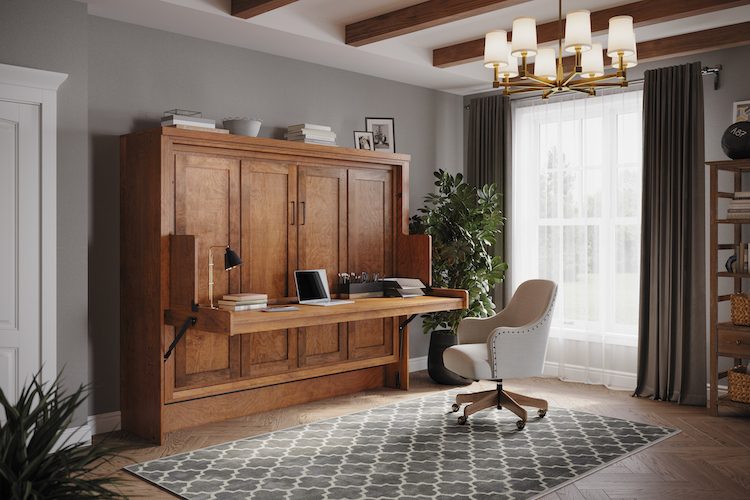
If your home office doubles as a guest room, a Murphy bed with an integrated desk is the perfect solution. These innovative pieces of furniture allow you to have a full-sized bed and a functional workspace in the same room without compromising on either.
During the day, fold up the bed to reveal a spacious desk area. Many models include additional storage compartments or shelving units, providing ample space for your office essentials. When it’s time for guests, simply clear off the desk and fold down the bed for a comfortable sleeping area. This dual-purpose furniture is a game-changer for those living in small apartments or homes with limited spare rooms.
8. Nesting Tables

Nesting tables are a versatile addition to any small home office. These sets of tables in graduated sizes can be stacked together when not in use, taking up minimal floor space. When you need extra surface area for spreading out documents or working on a larger project, simply pull out the additional tables.
Look for nesting tables with wheels for easy mobility, or choose sets with different heights to create a dynamic workspace. Some nesting table sets even come with built-in power outlets or USB charging ports, making them perfect for setting up temporary workstations or collaborative areas when needed.
9. Convertible Standing Desks
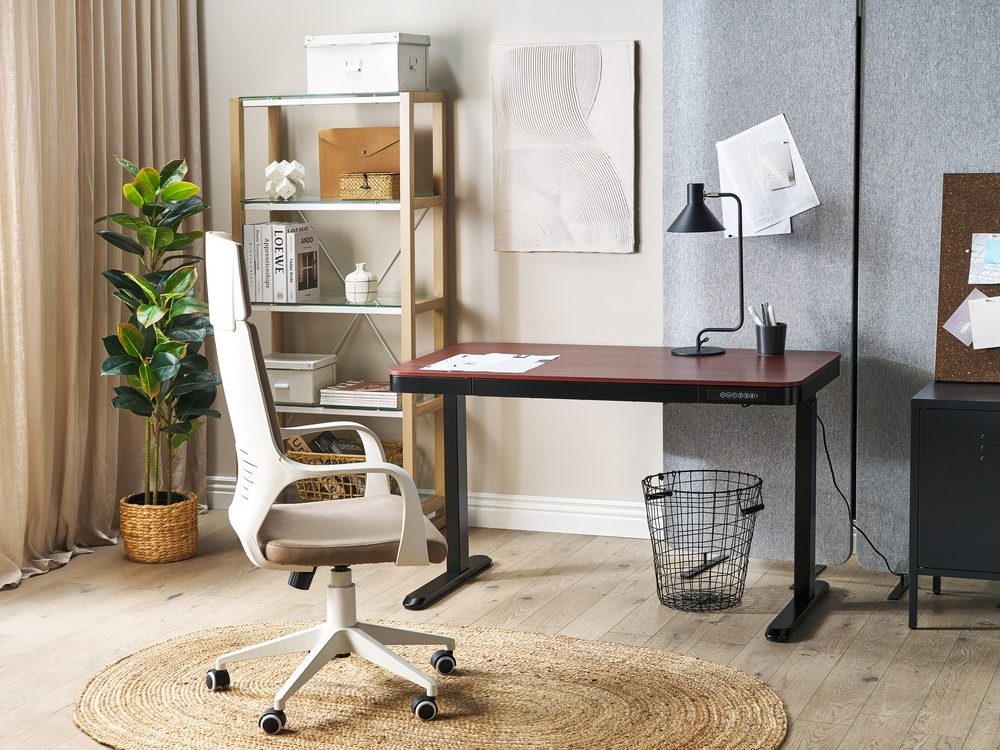
Standing desks have gained popularity for their health benefits, but they can take up a lot of space. Enter the convertible standing desk – a compact solution that allows you to switch between sitting and standing positions without dedicating a large area to a full-sized standing desk.
These innovative desks often feature a pneumatic lift system that allows you to easily adjust the height of your work surface. When you need to sit, lower the desk to a comfortable height. When you want to stand, simply raise it up. Look for models with built-in keyboard trays or monitor stands for added ergonomic benefits. Some convertible standing desks are even designed to be mounted on existing desks or tables, making them a perfect addition to your current setup.
10. Ottoman with Storage

An ottoman with storage serves double duty as both seating and storage in your small home office. Use it to store rarely-used office supplies, files, or even extra tech gear. When you need an extra seat for a client or collaborator, simply pull it up to your desk.
Choose an ottoman with a lift-top lid for easy access to your stored items. Some models even come with built-in trays that can be used as impromptu work surfaces or for holding drinks and snacks during long work sessions. Look for ottomans with casters for easy mobility, allowing you to quickly reconfigure your space as needed.
Clever Storage Solutions
In a small home office, smart storage is key to maintaining a clutter-free and productive environment. Here are some innovative storage ideas to help you make the most of your space:
11. Under-Desk File Cabinets

Make use of the space under your desk with a compact file cabinet on wheels. These versatile units provide ample storage for documents and office supplies while being easily movable when you need to reconfigure your space.
Look for file cabinets with a mix of drawers to accommodate different storage needs. Some models come with a cushioned top, allowing them to double as extra seating when needed. Consider options with built-in locks to keep sensitive documents secure, especially if your home office is in a shared space.
Related Guide: 75 Unique Cozy Home Office Ideas
12. Magnetic Strips

Install magnetic strips on your wall or the side of your desk to keep metal office supplies like scissors, paper clips, and small tools organized and within reach. This simple solution frees up drawer space and adds a sleek, modern touch to your office decor.
Experiment with different lengths and placements of magnetic strips to create an eye-catching storage display. You can even use stronger magnets to hold up lightweight containers or small metal baskets, further expanding your storage options. This flexible system allows you to easily rearrange your supplies as your needs change.
13. Door-Mounted Organizers

Maximize the often-overlooked space on the back of your office door with a door-mounted organizer. These hanging units typically feature multiple pockets of various sizes, perfect for storing office supplies, files, and even small electronics.
Choose a clear plastic organizer for easy visibility of your items, or opt for a fabric version for a softer look. Some door-mounted organizers come with adjustable straps, allowing you to customize the height to suit your needs. This storage solution is particularly useful if you’re working in a converted closet or other small space where wall space is limited.
14. Desk Organizers with Multiple Compartments
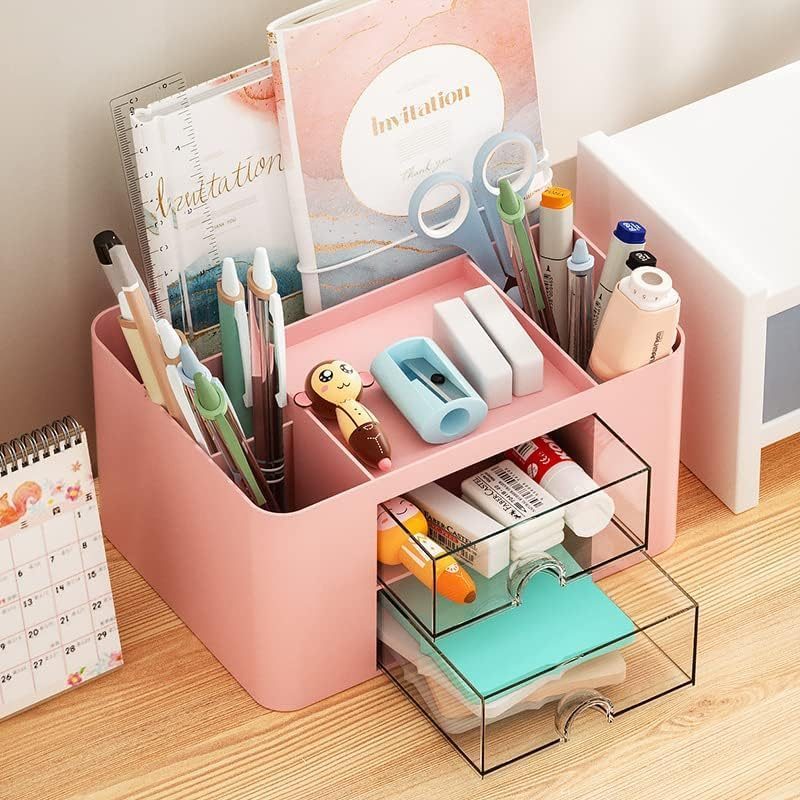
Keep your desk tidy and your supplies easily accessible with a multi-compartment desk organizer. These units typically feature a combination of drawers, slots, and open compartments to accommodate a variety of office essentials.
Look for desk organizers made from materials that complement your office decor, such as bamboo for a natural look or acrylic for a more modern aesthetic. Some models come with adjustable dividers, allowing you to customize the compartments to fit your specific needs. Consider stacking multiple organizers if you need additional storage space.
15. Hanging File Boxes
For a stylish and space-saving way to store important documents, consider using hanging file boxes. These decorative boxes can be mounted on the wall or placed on shelves, keeping your files organized and easily accessible without taking up valuable desk or floor space.
Choose hanging file boxes in colors or patterns that complement your office decor. Some models come with built-in label holders, making it easy to identify the contents at a glance. You can even use these boxes to store magazines, catalogs, or other reference materials, keeping your workspace clutter-free and visually appealing.
Maximizing Natural Light
Natural light can make a small office feel more spacious and inviting. Here are some ideas to maximize the natural light in your workspace:
16. Mirror Placement

Strategically place mirrors to reflect natural light and create the illusion of a larger space. A large mirror opposite a window can dramatically increase the amount of light in your office while also making the room feel more open.
Experiment with different mirror shapes and sizes to find the perfect balance for your space. Consider a full-length mirror leaning against the wall for a dramatic effect, or a collection of smaller mirrors arranged in an artistic pattern. Mirrors with metallic or reflective frames can add an extra touch of brightness to your office.
17. Light-Colored Paint

Opt for light, neutral colors when painting your office walls. Shades of white, cream, or pale grey can help reflect light and make your space feel more open and airy. These colors also provide a clean backdrop for your office decor and help reduce eye strain during long work hours.
Consider using a semi-gloss or satin finish paint to further enhance light reflection. If you want to add some personality to your space, use brighter colors as accents on one wall or in your office accessories. Light-colored paint can also make it easier to see and appreciate the texture of your walls, adding depth to your office design.
18. Transparent Furniture

Incorporate transparent or translucent furniture pieces to maintain an open, airy feel in your small office. Glass-top desks, acrylic chairs, or lucite storage units allow light to pass through, reducing visual clutter and making your space feel less cramped.
When choosing transparent furniture, pay attention to the quality and thickness of the materials to ensure durability. Look for pieces with interesting shapes or subtle tints to add visual interest without overwhelming your space. Pairing transparent furniture with light-colored or reflective surfaces can further enhance the bright, open feel of your office.
19. Lightweight Window Treatments

Choose lightweight, sheer curtains or blinds that allow natural light to filter through while still providing privacy when needed. Avoid heavy drapes that can block light and make your space feel smaller.
Consider using adjustable window treatments like cellular shades or roman blinds that can be easily raised or lowered to control light levels throughout the day. Light-colored or neutral window treatments can help maintain a bright, airy feel, while adding a subtle pattern or texture can introduce visual interest without overwhelming your space.
20. Reflective Surfaces

Incorporate reflective surfaces throughout your office to bounce light around the room. This can include metallic picture frames, glossy desk accessories, or even a small tabletop water feature.
Look for ways to add reflective elements that serve multiple purposes. For example, a metallic lamp base can provide both illumination and light reflection. Consider using reflective wallpaper or tiles as an accent to create a focal point while also enhancing the brightness of your space. Even small details like chrome drawer pulls or polished metal organizers can contribute to a brighter, more open-feeling office.
Ergonomic Considerations
Comfort is crucial in any workspace, especially in a small home office where you might be spending long hours. Here are some ergonomic ideas to consider:
21. Adjustable Chair

Invest in a high-quality, adjustable office chair that provides proper support for your back, neck, and arms. Look for chairs with lumbar support, adjustable armrests, and seat height adjustment to ensure optimal comfort throughout your workday.
Consider chairs with breathable materials to keep you cool during long work sessions. Some ergonomic chairs come with additional features like adjustable headrests or the ability to recline, which can be beneficial for taking short breaks or changing positions throughout the day. Remember that even in a small space, your comfort should be a top priority.
22. Monitor Arm

A monitor arm allows you to position your screen at the perfect height and distance, reducing neck and eye strain. These adjustable arms also free up valuable desk space, allowing you to use the area underneath for storage or other tasks.
Look for monitor arms with a wide range of motion, allowing you to easily switch between sitting and standing positions if you have a convertible desk. Some models can support multiple monitors, which is ideal if your work requires extensive multitasking. Consider arms with built-in cable management features to keep your workspace tidy and organized.
23. Keyboard Tray

Install a pull-out keyboard tray to ensure your arms are at the correct typing angle, reducing the risk of repetitive strain injuries. This also frees up desk space when the keyboard is not in use.
Choose a keyboard tray with adjustable height and tilt to find the most comfortable position for your wrists. Some models come with integrated wrist rests for added support. Look for trays with mouse platforms that can be positioned on either side to accommodate both right and left-handed users. A high-quality keyboard tray can significantly improve your comfort and productivity in a small office setting.
24. Footrest
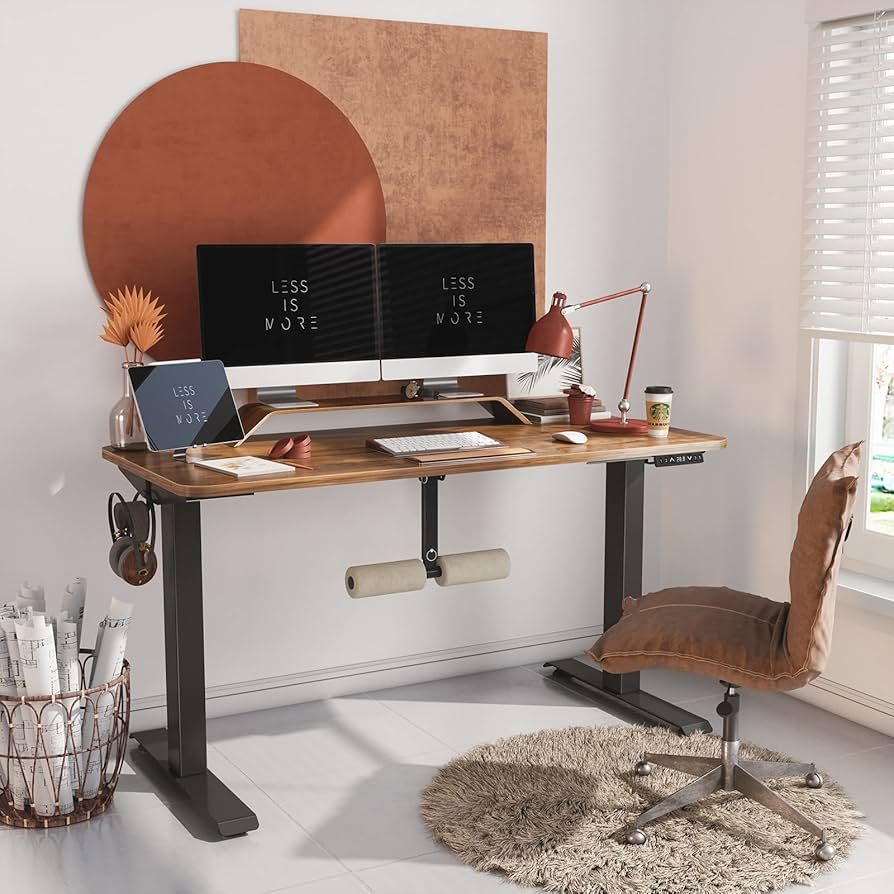
A footrest can help improve your posture and reduce pressure on your lower back, especially if your feet don’t comfortably reach the floor when seated. Choose an adjustable footrest to find the perfect height for your needs.
Consider footrests with textured surfaces or massaging features for added comfort and circulation benefits. Some models are designed to encourage subtle movements throughout the day, which can help reduce stiffness from prolonged sitting. In a small office, look for compact footrests that can be easily stored away when not in use.
25. Anti-Fatigue Mat

If you use a standing desk or spend a lot of time on your feet, an anti-fatigue mat can provide cushioning and support, reducing strain on your feet, legs, and lower back. These mats are especially useful in small offices where you might be alternating between sitting and standing throughout the day.
Look for anti-fatigue mats made from durable materials that can withstand frequent use. Some mats come with contoured surfaces or massage nodes to encourage subtle movements and improve circulation. Choose a mat that complements your office decor and is easy to clean. In a small space, consider a foldable or rollable mat that can be stored away when not in use.
Color Psychology and Decor
The colors and decor in your home office can significantly impact your mood and productivity. Here are some ideas to create an inspiring and motivating workspace:
26. Accent Wall

Create a focal point in your small office by painting one wall in a bold, energizing color. This can add depth to your space and provide a backdrop for motivational artwork or a gallery wall. Choose a color that inspires creativity and focus, such as a deep blue or vibrant green.
When selecting your accent wall color, consider the psychological effects of different hues. For example, blue can promote calmness and concentration, while yellow can stimulate creativity and optimism. If you’re hesitant about committing to a bold paint color, consider using removable wallpaper or large artwork to create a similar effect. An accent wall can also serve as a backdrop for video calls, adding visual interest to your virtual meetings.
27. Plants and Greenery
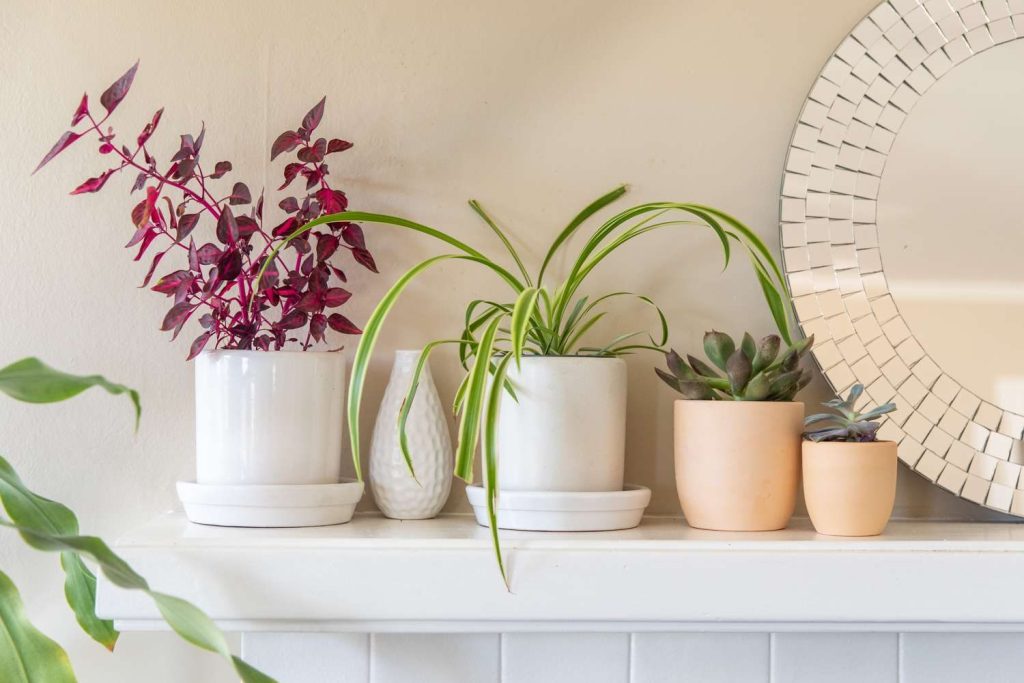
Incorporate plants into your office decor to improve air quality and add a touch of nature to your workspace. Even in a small office, you can find room for compact plants like succulents, air plants, or small potted herbs.
Consider hanging plants or wall-mounted planters to save desk and floor space. Vertical gardens or living walls can create a stunning focal point while maximizing your greenery in a small area. If you don’t have a green thumb or your office lacks natural light, high-quality artificial plants can provide a similar aesthetic boost without the maintenance requirements. Remember that interacting with plants, even briefly, can help reduce stress and increase productivity.
28. Inspirational Artwork

Hang inspirational quotes, motivational posters, or artwork that resonates with you and your goals. This not only personalizes your space but can also serve as a source of motivation during challenging work days.
When selecting artwork for a small office, consider pieces that complement your color scheme and don’t overwhelm the space. A gallery wall with a mix of small framed prints can add visual interest without making the room feel cluttered. For a more flexible option, consider using a magnetic or cork board to display inspirational items that you can easily change as your mood or goals evolve.
29. Personal Mementos

Include a few carefully chosen personal items, such as family photos, travel souvenirs, or small keepsakes, to make your office feel more inviting and personal. These items can serve as reminders of your personal life and motivations outside of work.
In a small space, be selective with your personal mementos to avoid clutter. Consider rotating items seasonally to keep your space fresh and interesting. Display personal items on floating shelves or in a small, dedicated area of your desk to maintain a professional appearance while still infusing your personality into the space.
30. Ambient Lighting

Incorporate soft, ambient lighting to create a cozy atmosphere and reduce eye strain. This can include table lamps, floor lamps, or even string lights, depending on your personal style and the mood you want to create in your office.
Look for space-saving lighting options like clip-on desk lamps or wall-mounted sconces to add warmth without taking up valuable surface area. Consider using smart bulbs that allow you to adjust the color temperature throughout the day, mimicking natural light patterns to support your circadian rhythm. Dimmable lights can also help you transition between focused work time and more relaxed brainstorming sessions.
Technology and Connectivity
In today’s digital world, having the right tech setup is crucial for a productive home office. Here are some ideas to optimize your technology and connectivity in a small space:
31. Wireless Peripherals
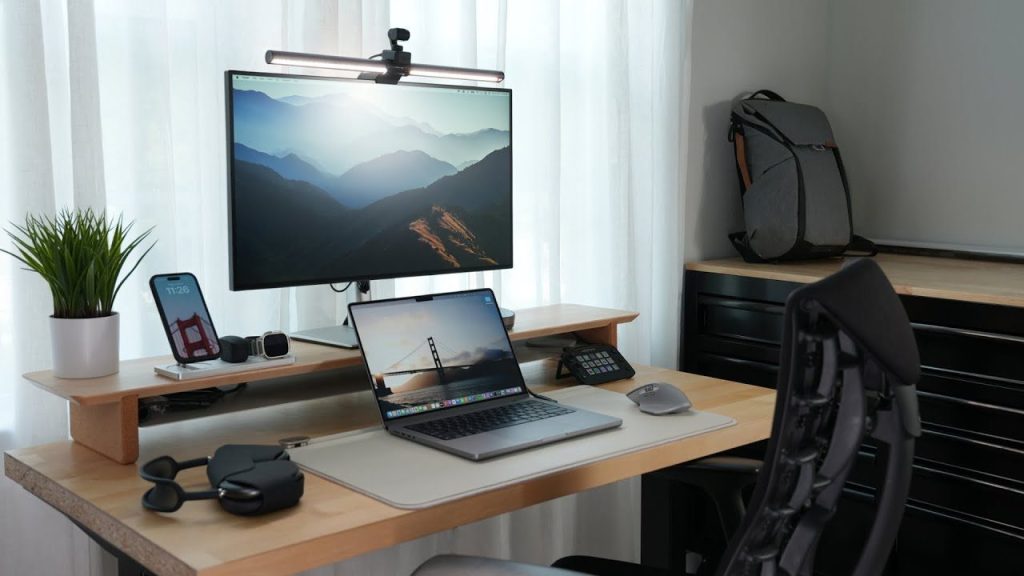
Opt for wireless keyboards, mice, and headphones to reduce cable clutter and maintain a clean, organized desk. This not only looks better but also gives you more flexibility in how you arrange your workspace.
When choosing wireless peripherals, look for options with long battery life to minimize interruptions to your workflow. Some wireless keyboards and mice can connect to multiple devices, allowing you to easily switch between your computer, tablet, and smartphone. Consider ergonomic designs to support your comfort during long work sessions.
32. Cable Management Solutions

Use cable clips, cord organizers, and cable sleeves to keep wires tidy and out of sight. This not only improves the appearance of your office but also reduces tripping hazards and makes it easier to clean your space.
Look for desk grommets or cable management boxes that can hide power strips and excess cord length. Some desks come with built-in cable management features, which can be a great option for a small office. Consider using velcro cable ties or reusable zip ties for easy adjustments as your setup changes over time.
33. Compact All-in-One Printer

Choose a compact, all-in-one printer that combines printing, scanning, and copying functions in a single device. Look for wireless models that can be placed on a shelf or in a nearby closet to save desk space.
Consider your printing needs carefully when selecting a printer. If you rarely need to print in color, a monochrome laser printer might be more cost-effective and space-efficient. Some all-in-one printers now come with smart features like voice control or the ability to print directly from cloud storage, which can streamline your workflow in a small office.
34. Charging Station
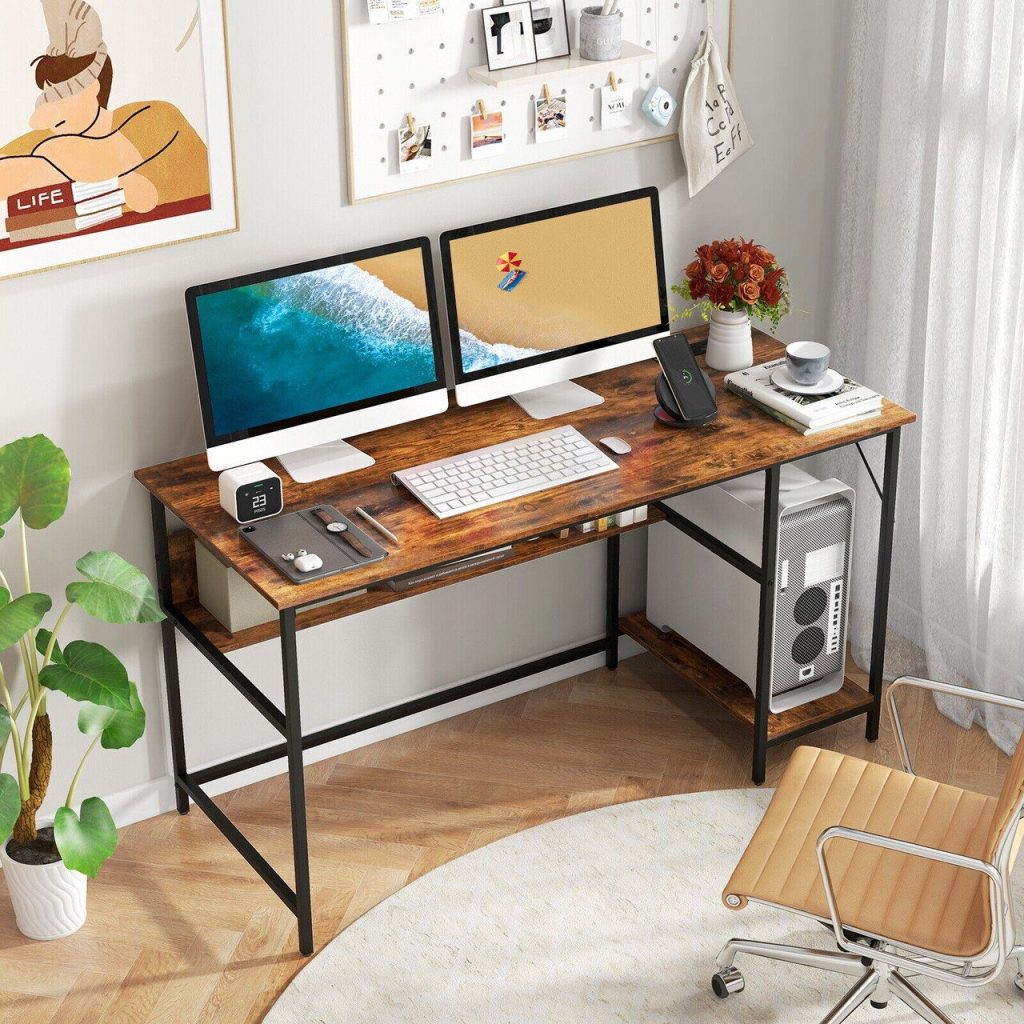
Create a dedicated charging station for your devices to keep cords organized and ensure your tech is always ready to go. This can be as simple as a small tray with a multi-port USB charger or a more elaborate setup with individual docks for each device.
Look for charging stations with fast-charging capabilities to minimize downtime. Some models come with built-in organization features like slots for tablets or phones, helping to keep your desk clutter-free. Consider placing your charging station in a drawer or on a shelf to keep it out of sight when not in use.
35. Smart Home Integration

Integrate smart home devices into your office setup for added convenience and efficiency. This can include smart speakers for hands-free commands, smart plugs for easy power management, or smart lighting systems for automated brightness control.
When incorporating smart devices, consider how they can specifically benefit your work routine. For example, a smart thermostat can ensure your office is at the perfect temperature when you start your workday, while a smart display can show your calendar and to-do list at a glance. Look for devices that are compatible with your existing smart home ecosystem to ensure seamless integration.
Noise Management
Managing noise levels is crucial in a home office, especially if you share your living space with others. Here are some ideas to create a quieter, more focused work environment:
36. Acoustic Panels

Install acoustic panels on your walls or ceiling to absorb sound and reduce echo, creating a more pleasant acoustic environment for video calls and concentration. These panels come in various sizes and designs, allowing you to incorporate them into your office decor.
When choosing acoustic panels, look for options that complement your office’s color scheme and style. Some panels can be customized with printed designs or photos, turning them into functional art pieces. In a small space, consider using a combination of wall-mounted panels and free-standing room dividers for maximum flexibility and sound absorption.
37. White Noise Machine

Use a white noise machine or app to mask distracting background noises and create a consistent audio environment. This can be especially helpful if your home office is near a busy street or in a shared living space.
Experiment with different types of ambient sounds to find what works best for you. Some people prefer natural sounds like rainfall or ocean waves, while others find more success with pure white noise or low-frequency brown noise. Many white noise machines now come with customizable sound options and sleep timers, allowing you to tailor the audio environment to your specific needs throughout the day.
38. Noise-Cancelling Headphones
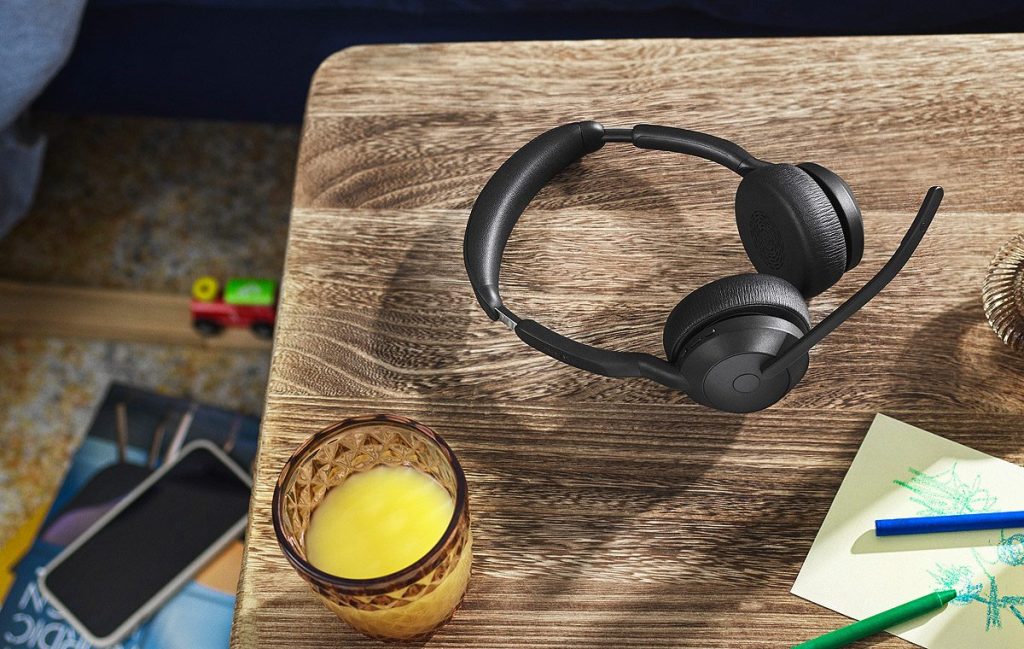
Invest in a good pair of noise-cancelling headphones to block out ambient noise and help you focus on your work. This is especially useful for video calls or when you need to concentrate in a noisy environment.
Look for headphones with comfortable ear cups and a long battery life for extended wear during your workday. Some models offer adjustable levels of noise cancellation, allowing you to let in some ambient sound when necessary. Consider headphones with a built-in microphone for seamless transitions between focused work and video calls.
39. Door Sweep
If your home office has a door, install a door sweep at the bottom to block sound from entering or leaving the room. This simple addition can significantly improve sound isolation, especially if you live in a busy household.
Choose a door sweep that’s easy to install and doesn’t interfere with the door’s operation. Some models are adjustable, allowing you to fine-tune the seal for maximum effectiveness. If you’re renting or don’t want to make permanent modifications, consider using a removable draft stopper that can be placed against the door when needed.
40. Fabric Elements

Incorporate soft, sound-absorbing materials into your office decor. This can include plush area rugs, fabric-covered bulletin boards, or textured wall hangings. These elements not only dampen sound but also add warmth and comfort to your space.
When selecting fabric elements, consider both their acoustic properties and their visual impact on your space. Heavier fabrics like velvet or wool tend to absorb more sound than lighter materials. In a small office, look for dual-purpose items like an upholstered ottoman that can serve as both extra seating and a sound-absorbing element.
Organizational Systems
Keeping your small home office organized is key to maintaining productivity and reducing stress. Here are some ideas for creating effective organizational systems:
41. Color-Coded Filing System

Implement a color-coded filing system to quickly identify and access important documents. Assign different colors to various categories of paperwork, such as finances, client files, or personal documents.
Use colored file folders, labels, or even washi tape to create your color-coding system. Consider creating a legend or key that explains your color system and keep it visible in your workspace. This visual organizational method can save you time and reduce frustration when searching for specific documents in a small office where space for extensive filing systems may be limited.
42. Digital Document Management

Minimize physical paperwork by scanning documents and implementing a digital filing system. Use cloud storage solutions to keep your files accessible from any device while freeing up physical space in your office.
Establish a consistent naming convention for your digital files to make them easy to search and organize. Consider using OCR (Optical Character Recognition) software to make scanned documents searchable. Set up automatic backups to ensure your important digital files are always protected. In a small office, transitioning to a primarily digital system can significantly reduce clutter and make better use of your limited space.
Related Guide: 100 Creative Cozy Living Room Ideas
43. Task Management Board
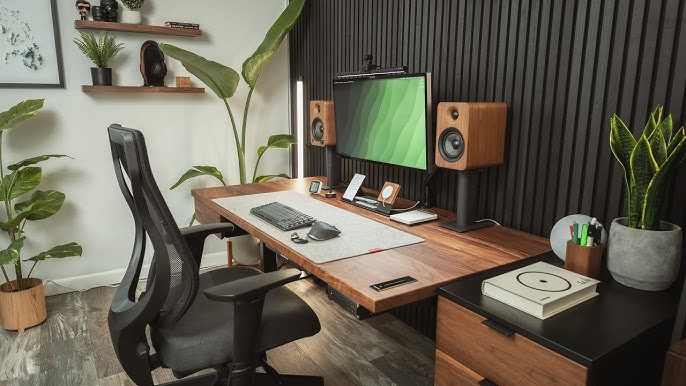
Create a visual task management system using a whiteboard, bulletin board, or digital display. This can help you prioritize your work and stay on top of deadlines without cluttering your desk with numerous to-do lists.
Experiment with different task management methods like Kanban boards or the Eisenhower Matrix to find what works best for you. In a small office, consider using a magnetic whiteboard that can double as a place to display important notes or inspirational messages. Digital alternatives like project management apps can offer similar functionality without taking up any physical space.
44. Drawer Organizers

Use drawer organizers to compartmentalize office supplies and keep everything in its place. This makes it easy to find what you need quickly and prevents drawers from becoming cluttered catch-alls.
Look for adjustable drawer organizers that can be customized to fit your specific needs and drawer dimensions. Consider using clear organizers to easily see the contents without having to open every compartment. In a small office, maximize vertical space within drawers by using stacking organizers or creating multi-tiered systems.
45. Label Maker

Invest in a label maker to clearly mark storage containers, file folders, and shelves. This not only helps you stay organized but also creates a cohesive, professional look in your office.
When labeling, be specific but concise to make items easy to identify at a glance. Consider using waterproof labels for items that might be exposed to moisture or frequent handling. In a small office where space is at a premium, clear labeling can help you quickly locate items without having to search through multiple storage areas.
Comfort and Wellness
Creating a comfortable and health-promoting environment is crucial in a home office, especially when space is limited. Here are some ideas to enhance your comfort and well-being:
46. Sit-Stand Desk Converter

If you don’t have room for a full standing desk, consider a sit-stand desk converter. These units sit on top of your existing desk and can be easily adjusted to allow you to alternate between sitting and standing throughout the day.
Look for converters with smooth, easy-to-use lifting mechanisms. Some models come with built-in keyboard trays or tablet holders for added ergonomic benefits. In a small office, choose a converter that can be easily folded down or moved aside when you need to use your full desk surface for other tasks.
47. Under-Desk Exerciser
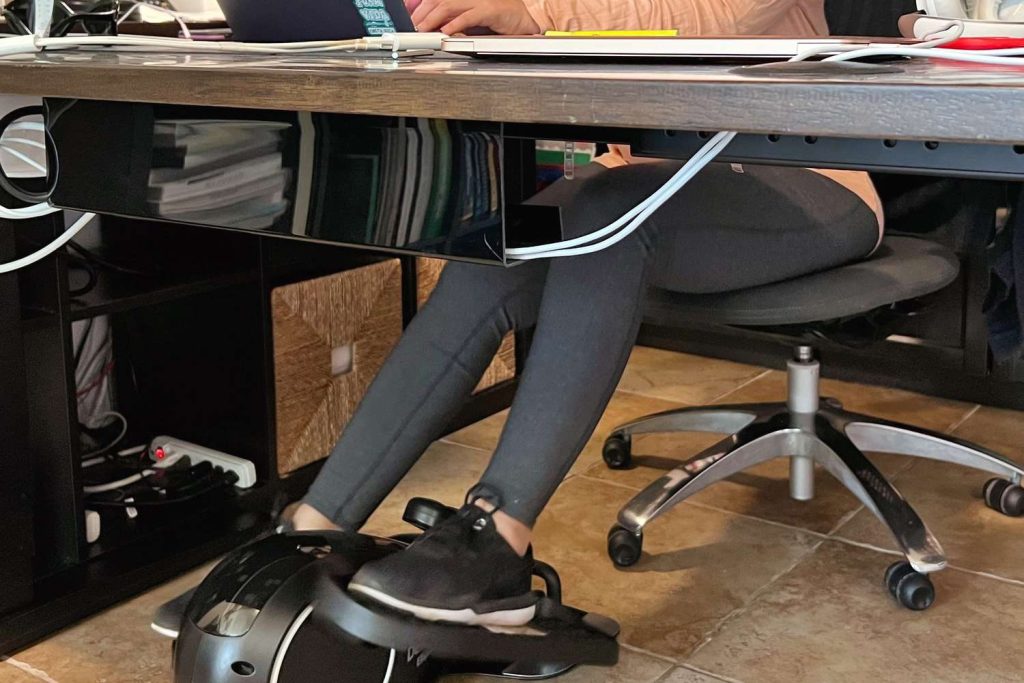
Incorporate an under-desk exerciser, such as a mini elliptical or bike pedals, to promote movement during long periods of sitting. These compact devices allow you to engage in light exercise without taking up additional floor space.
When choosing an under-desk exerciser, look for quiet models that won’t disturb your concentration or video calls. Some devices come with resistance adjustments, allowing you to customize your workout. Consider models with digital displays or smartphone connectivity to track your activity throughout the day.
48. Essential Oil Diffuser

Use a compact essential oil diffuser to introduce calming or energizing scents into your workspace. Aromatherapy can help reduce stress, improve focus, and create a more pleasant work environment.
Choose a diffuser with a timer function to control the duration of scent release. Experiment with different essential oil blends to find what works best for your mood and productivity. In a small office, look for ultrasonic diffusers that double as humidifiers, helping to maintain optimal air quality in your workspace.
49. Portable Air Purifier

Improve the air quality in your office with a small, portable air purifier. This can help reduce allergens, dust, and other airborne particles, creating a healthier work environment.
Look for air purifiers with HEPA filters for maximum effectiveness. Consider models with multiple fan speeds and quiet operation for use during video calls or concentrated work periods. In a small office, choose a purifier with a compact footprint that can be easily moved or stored when needed.
50. Desk Plant

Include a small, low-maintenance plant on your desk to improve air quality and add a touch of nature to your workspace. Plants can help reduce stress and increase productivity, even in small doses.
Choose plants that thrive in office conditions, such as snake plants, pothos, or succulents. Consider using a self-watering planter to reduce maintenance needs. In a small office, look for compact plants that won’t take up too much desk space or opt for wall-mounted planters to keep your work surface clear.
Aesthetic and Personal Touch
Making your small home office visually appealing and personally meaningful can significantly improve your mood and productivity. Here are some ideas to add style and personality to your workspace:
51. Gallery Wall

Create a mini gallery wall with a collection of small framed prints, photographs, or inspirational quotes. This adds visual interest to your space without taking up valuable work surface area.
When designing your gallery wall, consider using a mix of frame sizes and orientations for a dynamic look. Choose a cohesive color scheme or theme to tie the elements together. In a small office, opt for lightweight frames that can be easily hung with removable hooks to avoid damaging walls.
52. Decorative Storage

Choose storage solutions that are both functional and aesthetically pleasing. This might include woven baskets, vintage tins, or decorative boxes that complement your office decor while providing practical storage space.
Look for storage items that can serve multiple purposes, such as a stylish box that can hold office supplies and double as a laptop stand. Consider using a variety of textures and materials to add visual interest to your space. In a small office, choose stackable or nesting storage options to maximize vertical space.
53. Personalized Desk Accessories

Add a personal touch to your workspace with custom desk accessories. This could include a monogrammed mouse pad, a photo mug, or a unique pen holder that reflects your personality or interests.
When selecting personalized accessories, choose items that are both functional and meaningful to you. Consider creating a cohesive look by selecting accessories in a similar color scheme or style. In a small office, be selective with your choices to avoid cluttering your limited desk space.
54. Mood Lighting

Incorporate adjustable mood lighting to create different atmospheres in your office throughout the day. This could include a small desk lamp with color-changing bulbs or a strip of LED lights behind your monitor.
Look for lighting options that offer a range of color temperatures to support different types of work. Cool, blue-toned light can help with focus and productivity, while warmer tones are better for creative tasks or winding down at the end of the day. In a small office, choose compact light sources that can be easily adjusted or moved as needed.
55. Inspiration Board

Create a small inspiration board to display your goals, vision, and motivational elements. This can serve as a daily reminder of your aspirations and help keep you focused on your long-term objectives.
Use a small cork board, magnetic board, or even a designated area of your wall for your inspiration board. Include a mix of visual and textual elements, such as inspiring quotes, photos of your goals, or small tokens of past achievements. In a small office, consider making your inspiration board double as a functional element, such as a place to pin important notes or deadlines.
Conclusion
Creating a productive and inspiring home office in a small space is all about maximizing efficiency, comfort, and personalization. By implementing these 55 small home office ideas, you can transform even the tiniest corner into a powerhouse of productivity.
Remember, the key is to choose solutions that work best for your specific needs and work style. Don’t be afraid to experiment and adjust your setup over time as your needs change.
With creativity and smart planning, you can create a small home office that not only meets your professional needs but also reflects your personal style and enhances your overall work-from-home experience.

